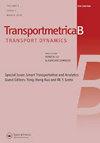入口匝道合流系统中基于虚拟排的自动驾驶汽车协同合流速度控制策略
IF 3.4
2区 工程技术
Q2 TRANSPORTATION
引用次数: 2
摘要
本文章由计算机程序翻译,如有差异,请以英文原文为准。
A cooperative merging speed control strategy of CAVs based on virtual platoon in on-ramp merging system
ABSTRACT This study proposed an on-ramp cooperative control strategy for connected and automated vehicles (CAVs) based on the virtual platoon method. First, the formation rules of the virtual platoon and merging conditions of the vehicles were introduced. Different control strategies were then arranged for different types of vehicle combinations in the virtual platoon. Merging speed control was proposed for vehicle combinations in different lanes. The simulation results showed that merging speed control effectively increases vehicle speed and reduces fuel consumption and average pollutant emissions. In the typical macroscopic simulation, the average speed of vehicles with merging speed control increased by 25%, while fuel consumption and average pollutant emissions decreased by 31.4% and 52%. A longer communication area, shorter desired gap headway, and smaller flow rate can lead to higher vehicle speed, lower fuel consumption and pollutant emissions. Fuel consumption and pollutant emissions are inversely proportional to the steady speed.
求助全文
通过发布文献求助,成功后即可免费获取论文全文。
去求助
来源期刊

Transportmetrica B-Transport Dynamics
TRANSPORTATION SCIENCE & TECHNOLOGY-
CiteScore
5.00
自引率
21.40%
发文量
53
期刊介绍:
Transportmetrica B is an international journal that aims to bring together contributions of advanced research in understanding and practical experience in handling the dynamic aspects of transport systems and behavior, and hence the sub-title is set as “Transport Dynamics”.
Transport dynamics can be considered from various scales and scopes ranging from dynamics in traffic flow, travel behavior (e.g. learning process), logistics, transport policy, to traffic control. Thus, the journal welcomes research papers that address transport dynamics from a broad perspective, ranging from theoretical studies to empirical analysis of transport systems or behavior based on actual data.
The scope of Transportmetrica B includes, but is not limited to, the following: dynamic traffic assignment, dynamic transit assignment, dynamic activity-based modeling, applications of system dynamics in transport planning, logistics planning and optimization, traffic flow analysis, dynamic programming in transport modeling and optimization, traffic control, land-use and transport dynamics, day-to-day learning process (model and behavioral studies), time-series analysis of transport data and demand, traffic emission modeling, time-dependent transport policy analysis, transportation network reliability and vulnerability, simulation of traffic system and travel behavior, longitudinal analysis of traveler behavior, etc.
 求助内容:
求助内容: 应助结果提醒方式:
应助结果提醒方式:


